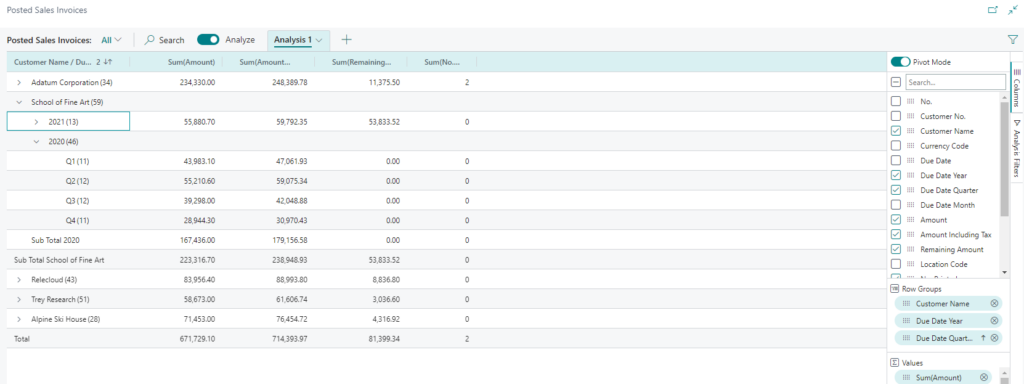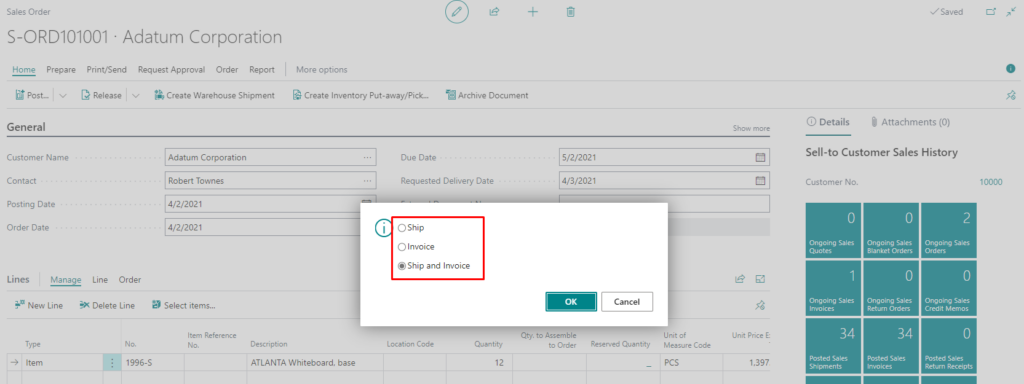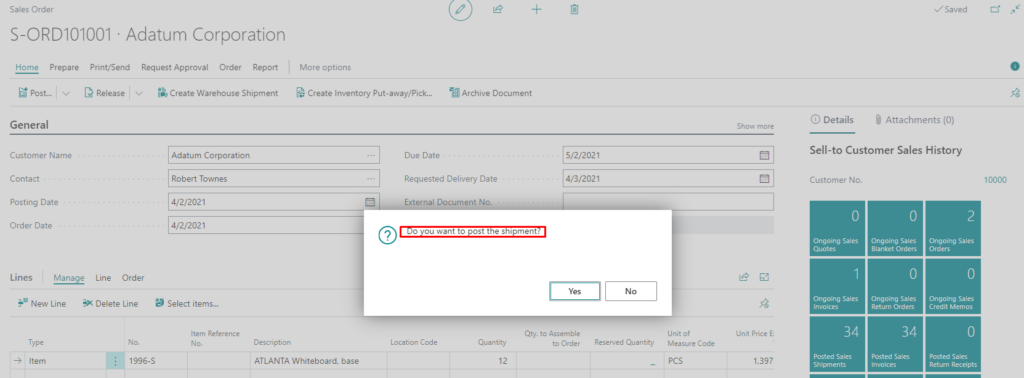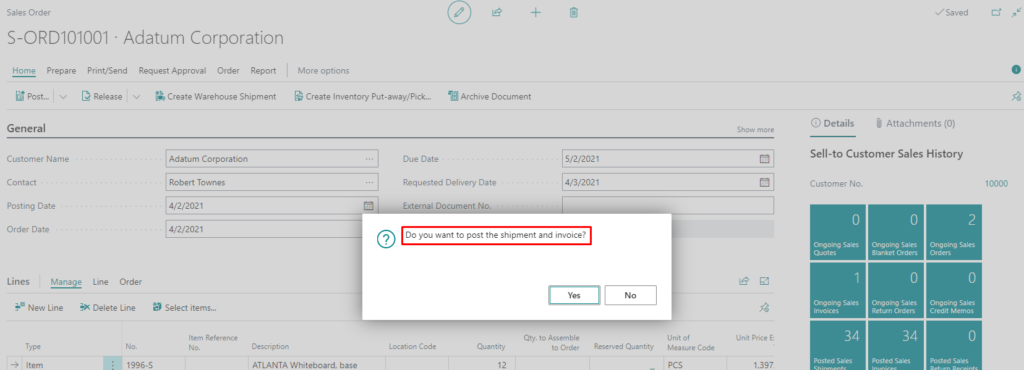It is upgrade time again for Business Central. Microsoft has two major version upgrades for Business Central each year in April and May. These upgrades come rich with new features, better usability, and increased functionality. We are going to dive into some of our favorite features from the most recent wave release, Microsoft Dynamics 365 Business Central 2023 release wave 1, version 22.
1. Analyze Mode
Possibly the most exciting feature coming to Business Central in version 22 is the Analyze Mode on list pages. This brings the ability to create pivot tables inside the Business Central UI and no more export pages from BC to create a couple of simple pivot tables.
Currently, this feature must be enabled through the Feature Management page in BC until the version 23 release later this year.

Once enabled users will now have an Analyze option at the top of key list pages within Business Central. This includes pages such as Posted Sales Invoices, Vendor Ledger Entries or General Ledger Entries.

As an example, you can go into Analyze mode on the Posted Sales Invoice screen to create a basic sales report. This report will display Sales by Quarter as well as the Remaining Amount to show unpaid invoices, including broken down by customer.

On top of this, I can now save this report to return to later without having to build the pivot table again. This feature significantly increases the ad-hoc reporting functionality in Business Central and decreases user requirements for exporting data to Excel on a regular basis to get their insights.
2. Sales/Purchase Invoice Posting Policy
A common request we receive from companies operating in teams with segregation of duties, such as a warehousing team who should not have access to invoicing orders, is to remove the ‘Ship and Invoice’ option from Sales Orders and Warehouse Shipments. With version 22 of Business Central, this is now doable natively for both purchasing and sales without requiring customizations.
This is a big value add for limiting a user’s functionality without modifying permissions or customizations to take the buttons away. This functionality is controlled on a per-user basis through the User Setup table where there are now two new fields, Sales Invoice Purchasing Policy and Purchase Invoice Posting Policy. Each field has three options: Allowed, Prohibited, and Mandatory.

Allowed: The Allowed value will function as BC has in the past. The user will be prompted with the traditional dialog box with three options when posting a document: Ship, Invoice and Ship and Invoice

Prohibited: Setting the Invoice Posting Policy to Prohibited will change this functionality to a yes or no confirmation box asking if you want to post the shipment.

Mandatory: Mandatory will enforce the user to post the Invoice and the Shipment of the document at the same time.

3. Statistical Accounts
The Business Central 2023 release wave 1, sees the introduction of genuine Statistical Accounts. Previously clients had used Statistical Account within the COA. It will have a separate ledger for Statistical Accounts that will operate on a number-based analysis, which can also be included in Financial Reports and Analysis Views for reporting. General Ledger entries do not tend to carry a quantity as the amount is the only value used and required for analytics and reporting.
The ability to use statistical accounts adds a new dimension to reporting which was previously unavailable in BC. A use case example of this could be an event company that wants to record ticket sales. This could be recorded day by day to be reported on in conjunction with revenue for the event.
There are various pages that have been added to the Statistical Accounts module. These include Statistical Accounts, Statistical Account Journal, and the Statistical Account Ledger Entries. The new pages let you set up and configure the Statistical Accounts, create Journal Entries for values into the accounts and view all Ledger Entries for Statistical Accounts.

As mentioned above, we can use the Statistical Account Journal to make entries to these accounts. You can make an entry to our Ticket Sales Statistical Account:

By utilizing Financial Reports and Statistical Accounts we can now add additional meaningful data to our reports. An example of this is the average ticket price as a metric. By taking the Ticket Sales Revenue and the Ticket Volume (number of ticket sales entered through the Statistical Accounts Journal) we are able to produce the average price of our ticket sales.

4. Item Tracking Details on Lines
A solid improvement for the implementation side of Business Central focuses on the Inventory section. If you have prepared opening balances for Inventory or worked with large item adjustments in Business Central, you may know the pains of adding bulk Item Tracking Details to the journal lines. In this new version, Microsoft is adding a new field on the Item Journal Batches Page called Item Tracking on Lines.

Enabling this field will add 4 additional columns to the Item Journal page for Serial No, Lot No, Expiration Date and Warranty Date.

Having these fields surfaced on the Item Journal and Warehouse Physical Inventory Journal removes the need for workers to open the Item Tracking subpage, enter the details and enable a line per serial number/lot number combination.
This feature will be a big efficiency for warehouse workers and bring a lot simpler opening balances for companies throughout their Business Central implementations. In addition to the Item Journal, these fields can be personalized into your view on the Warehouse Physical Inventory Journal page.
5. Master Data Sync Between Companies
The ability to sync master data from company to company in the same environment has been highly requested, and Microsoft has listened. This will allow businesses to automate the syncing of master data and assist with data management through their entire Business Central environment for multi-entity setups. A huge business value is added with this feature through data accuracy and decreasing the amount of manual data input required across multiple companies.
The Master Data Management Synchronization has a new page for the configuration. On this page it allows you to enable and disable tables to synchronize, manage the fields to synchronize and apply filters to the tables to control which data is synchronized from the source company. The following capabilities are also added for managing master data, as noted by Microsoft:
- Moving master data works when a company subscribes to data from another company.
- You can define the tables and fields to synchronize. For more control over the synchronization, you can filter on table records. You can also set up more advanced synchronization couplings.
- Changes in the main company are immediately pulled to the receiving companies by the job queue.
- Users in the receiving company can review synchronization logs.
Authors: Joshua Stove, Lead, Microsoft Business Applications | [email protected]
Devon Stove, Microsoft Business Central Consultant | [email protected]
Contact Us
Businesses are ready to put these new services and capabilities to work. If your organization needs to be taken to the next level with Microsoft Business Central, our CRM and ERP Consulting Services Team is here to help.




